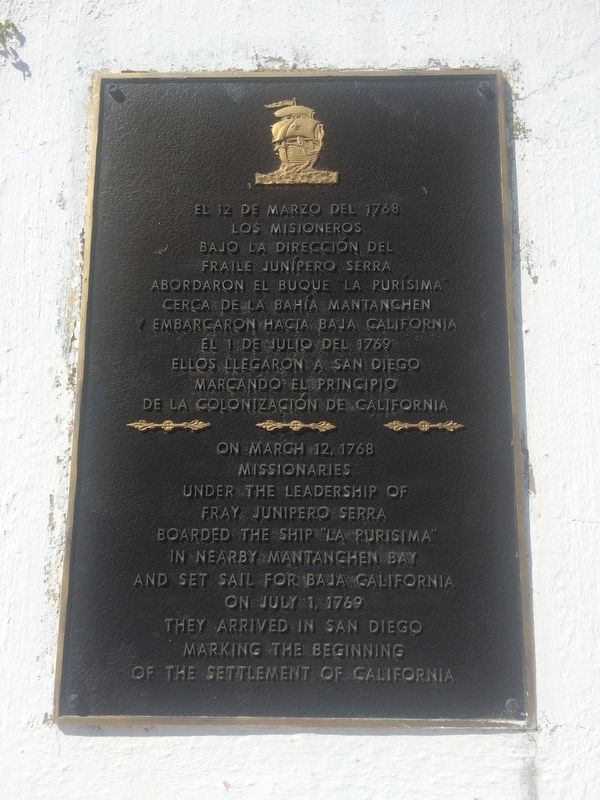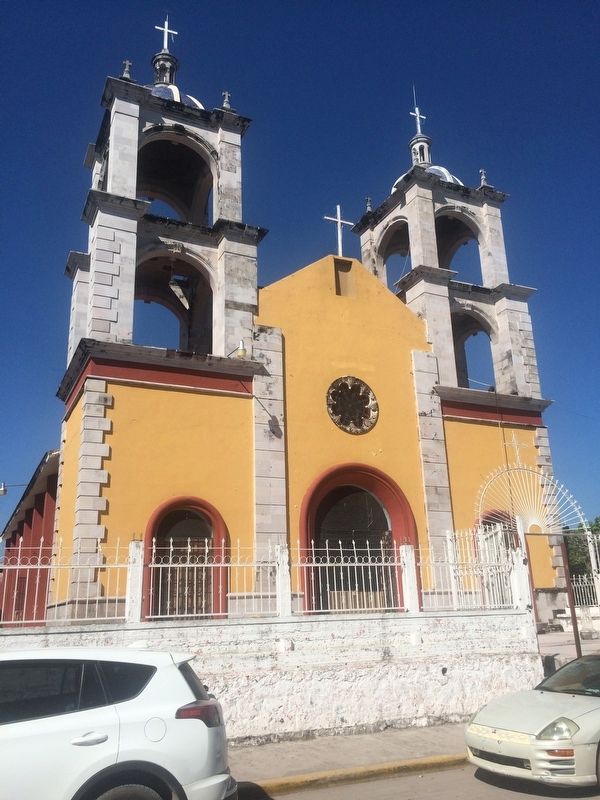San Blas, Nayarit, Mexico — The Pacific Coast (North America)
Fray Junipero Serra
los misioneros
bajo la dirección del
Fraile Junípero Serra
abordaron el buque "La Purísima"
cerca de la Bahía Mantanchen
y embarcaron hacia Baja California
El 1 de julio del 1769
ellos llegaron a San Diego
marcando el principio
de la colonización de California
English:
On March 12, 1768 missionaries
under the leadership of
Fray Junipero Serra
boarded the ship "La Purisima"
in nearby Mantanchen Bay
and set sail for Baja California
On July 1, 1769
they arrived in San Diego
marking the beginning of the settlement of California
Topics. This historical marker is listed in these topic lists: Churches & Religion • Colonial Era • Exploration • Settlements & Settlers. A significant historical date for this entry is March 12, 1768.
Location. 21° 32.515′ N, 105° 17.192′ W. Marker is in San Blas, Nayarit. Marker is on Calle Sinaloa just east of Calle H. Batallón de San Blas, on the right when traveling west. Touch for map. Marker is in this post office area: San Blas NAY 63740, Mexico. Touch for directions.
Other nearby markers. At least 4 other markers are within walking distance of this marker. José María Mercado (within shouting distance of this marker); Benito Pablo Juárez García (about 180 meters away, measured in a direct line); The San Blas Battalion (approx. 1.1 kilometers away); José María Mercado Burial Site (approx. 1.1 kilometers away).
Also see . . . San Blas, Nayarit, Mexico.
San Blas was founded in 1531, but the official date of founding is 1768, when Manuel Rivera and 116 families arrived on the orders of the Viceroy of New Spain, Marqués de Croix, under the supervision of José de Gálvez, who was visitador general ("inspector") of New Spain.
San Blas was the port from which the Spanish priest Junípero Serra, Father President of the California Missions, departed for California. He left on March 12, 1768 from the nearby Las Islitas beach on Matanchen Bay, in the locally built barque the Purísima Concepción.
A few months later, in May 1768, San Blas was designated as a new naval base for the Spanish Navy. At first, only two ships were assigned to the port: the packet boat San Carlos, commanded by Juan Pérez, and El Principe, commanded by Vicente Vila. Gálvez ordered four new vessels to be built, one of which was the schooner Sonora, which sailed in 1775 by Juan Francisco de la Bodega y Quadra to Alaska.
The San Carlos, under the command of Ayala, departed San Blas, Mexico, for San Francisco Bay, stopping in Monterey to unload supplies for the mission there on March 19, 1775. They reached Monterey Bay on June
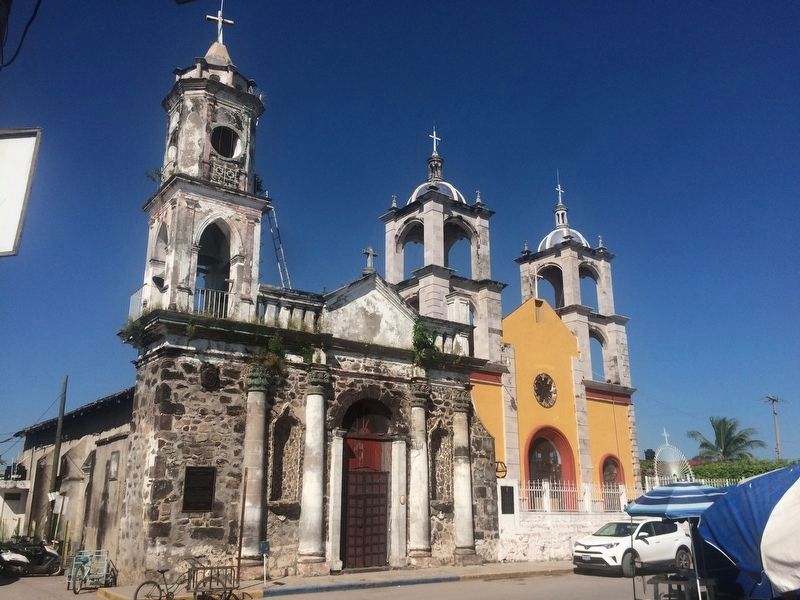
Photographed By J. Makali Bruton, November 15, 2016
2. Fray Junipero Serra Marker
The marker is between the two parish churches on the town square of San Blas. It is mounted to a whitewashed wall, just to the right of the older, 19th century stone church. To the left on the stone church is the additional marker of Longfellow's poem.
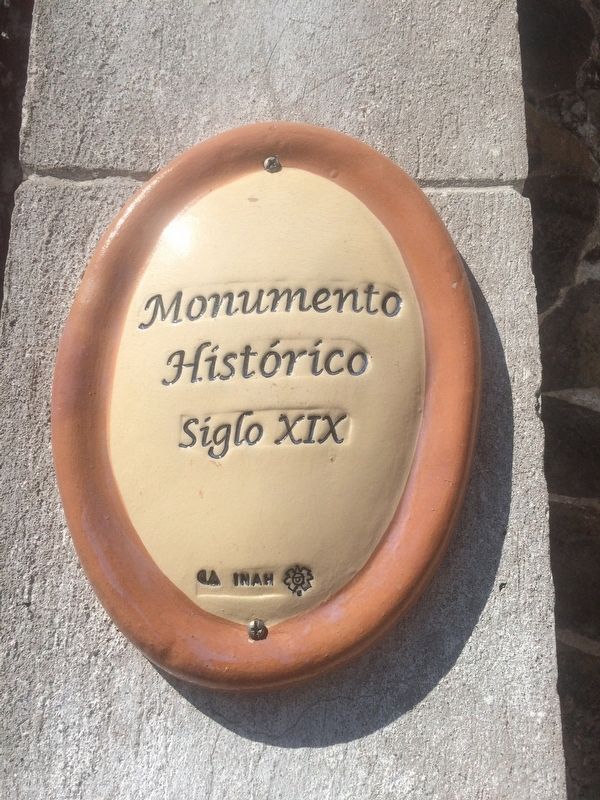
Photographed By J. Makali Bruton, November 15, 2016
4. Historical Monumento, 19th century, INAH (National Institute of Anthropology and History)
This additional marker is on the 19th century Catholic church located facing the central park. In Spanish it reads: Monumento Histórico, Siglo XIX, INAH (Instituto Nacional de Antropología y Historia).
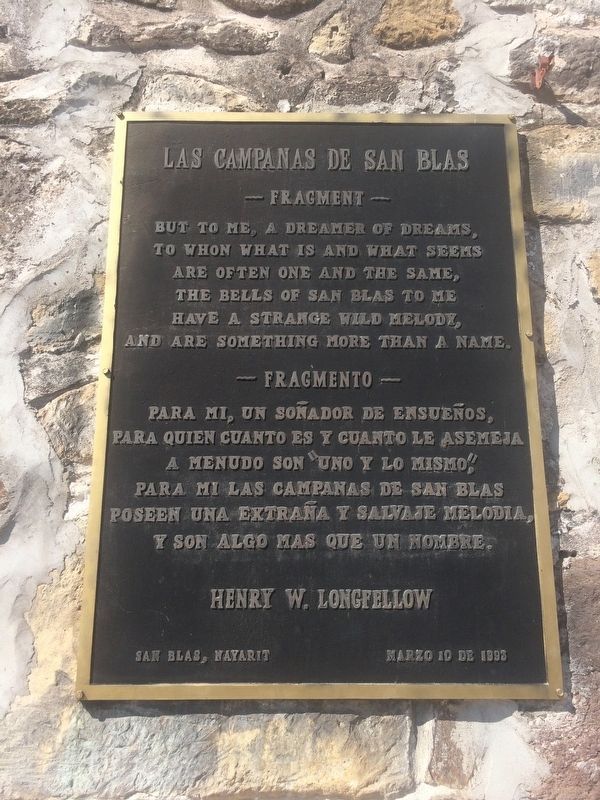
Photographed By J. Makali Bruton, November 15, 2016
5. An additional marker dedicated to Longfellow's poem "The Bells of San Blas"
Supposedly the last poem written by Longfellow, finished March 15, 1882. Mr. Longfellow died March 24. The poem was suggested by an article in Harper’s Magazine, which the poet had just read.
Las Campanas de San Blas
- Fragment -
But to me, a dreamer of dreams,
to whon what is and what seems
are often one and the same,
the bells of San Blas to me
have a strange wild memory,
and are something more than a name.
- Fragmento -
Para mi, un soñador de ensueños,
para quien cuanto es y cuanto le asemeja
a menduo son "uno y lo mismo",
para mi las campanas de San Blas
poseen una extraña y salvaje melodia,
y son algo mas que un nombre.
Henry W. Longfellow
San Blas, Nayarit, Marzo 10 de 1993
- Fragment -
But to me, a dreamer of dreams,
to whon what is and what seems
are often one and the same,
the bells of San Blas to me
have a strange wild memory,
and are something more than a name.
- Fragmento -
Para mi, un soñador de ensueños,
para quien cuanto es y cuanto le asemeja
a menduo son "uno y lo mismo",
para mi las campanas de San Blas
poseen una extraña y salvaje melodia,
y son algo mas que un nombre.
Henry W. Longfellow
San Blas, Nayarit, Marzo 10 de 1993
Credits. This page was last revised on April 29, 2017. It was originally submitted on November 15, 2016, by J. Makali Bruton of Accra, Ghana. This page has been viewed 372 times since then and 12 times this year. Photos: 1, 2, 3, 4, 5. submitted on November 15, 2016, by J. Makali Bruton of Accra, Ghana.
